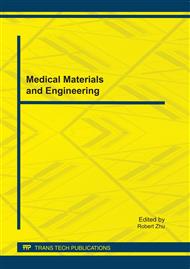[1]
Higgins, J. A., Higbee, D. R., Donahoo, W. T. et al. Resistant starch consumption promotes lipid oxidation, J. Nutr Metab. 1 (2004) 8–18.
Google Scholar
[2]
Brown, I. L. Applications and uses of resistant starch, J. JAOAC Int. 87 (2004) 727–732.
Google Scholar
[3]
Baixauli, R., Salvador, A., Hough, G. ea al. How information about fibre (traditional and resistant starch) influences consumer acceptance of muffins, J. Food Quality and Preference. 19 (2008) 628-635.
DOI: 10.1016/j.foodqual.2008.05.002
Google Scholar
[4]
Arimi, J. M., Duggan, E., O'Riordan, E. D. et al. Microwave expansion of imitation cheese containing resistant starch, J. Journal of Food Engineering. 88 (2008)254-262.
DOI: 10.1016/j.jfoodeng.2008.02.021
Google Scholar
[5]
Arimi, J. M., Duggan, E., O'Sullivan, M. et al. Effect of refrigerated storage on water mobility and microwave expansion of imitation cheese containing resistant starch, J. Journal of Food Engineering. 89 (2008) 258-266.
DOI: 10.1016/j.jfoodeng.2008.04.028
Google Scholar
[6]
Baixauli, R., Salvador, A., Martínez-Cervera, S. et al. Distinctive sensory features introduced by resistant starch in baked products, J. LWT - Food Science and Technology. 41 (2008) 1927-(1933).
DOI: 10.1016/j.lwt.2008.01.012
Google Scholar
[7]
Baixauli, R., Sanz, T., Salvador, A. et al. Muffins with resistant starch: Baking performance in relation to the rheological properties of the batter, J. Journal of Cereal Science. 47 (2008) 502-509.
DOI: 10.1016/j.jcs.2007.06.015
Google Scholar
[8]
Hollie, A., Grabitske, J., and Slavin, L. Low-Digestible Carbohydrates in Practice, J. Journal of the American Dietetic Association. 108 (2008) 1677-1681.
DOI: 10.1016/j.jada.2008.07.010
Google Scholar
[9]
Homayouni, A., Azizi, A., Ehsani, M. R. et al. Effect of microencapsulation and resistant starch on the probiotic survival and sensory properties of synbiotic ice cream, J. Food Chemistry. 111 (2008) 50-55.
DOI: 10.1016/j.foodchem.2008.03.036
Google Scholar
[10]
Koksel, H., Masatcioglu, T., Kahraman, K. et al. Improving effect of lyophilization on functional properties of resistant starch preparations formed by acid hydrolysis and heat treatment, J. Journal of Cereal Science. 47 (2008) 275-282.
DOI: 10.1016/j.jcs.2007.04.007
Google Scholar
[11]
Li, L., Jiang, H., Campbell, M. et al. Characterization of maize amylose-extender (ae) mutant starches. Part I: Relationship between resistant starch contents and molecular structures,J. Carbohydrate Polymers. 74 (2008) 396-404.
DOI: 10.1016/j.carbpol.2008.03.012
Google Scholar
[12]
Choi, S., and Kerr, W. L. 1H NMR studies of molecular mobility in wheat starch[J]. Food Research International. 36 (2003) 341–348.
DOI: 10.1016/s0963-9969(02)00225-9
Google Scholar
[13]
Ishida, N., and Takano, H. Architecture of baked breads depicted by a magnetic resonance imaging. Magnetic Resonance Imaging. 19 (2001) 867–874.
DOI: 10.1016/s0730-725x(01)00410-6
Google Scholar
[14]
Li Xinhua; Cui Jingtao; Zhong yan. Optimization study on processing conditions of corn resistant starch, J. food science. 29 (2008) 186-189.
Google Scholar
[15]
Goñi, I., García-Diz, L., Mañas, E. et al. Analysis of resistant starch: a method for foods and food products, J. Food Chem. 56 (1996) 445–449.
DOI: 10.1016/0308-8146(95)00222-7
Google Scholar
[16]
Dahlqvist, A. Method for assay of intestinal disaccharidases, J. Anal. Biochem. 7 (1964) 18-25.
Google Scholar
[17]
Shelke, K., Faubion, J. M., Hoseney, R. C. The dynamics of cake baking as studied by a combination of viscosimetry and electrical resistance oven heating,J. Cereal Chemistry. 67 (1990) 575–580.
Google Scholar
[18]
Duggan, E., Noronha, N., O'Riordan, E. D. et al. Effect of resistant starch on the water binding properties of imitation cheese,J. Journal of Food Engineering. 84 (2008) 108-115.
DOI: 10.1016/j.jfoodeng.2007.04.028
Google Scholar
[19]
Ruan, R., and Chen, P. Water in foods and biological materials: A nuclear magnetic resonance approach. Publisher: C R C Press LLC. (2003).
Google Scholar
[20]
Sanz, T., Salvador, A., and Fiszman, S. M. Resistant starch (RS) in battered fried products: Functionality and high-fibre benefit, J. Food Hydrocolloids. 2 (2008) 543-549.
DOI: 10.1016/j.foodhyd.2007.01.018
Google Scholar


